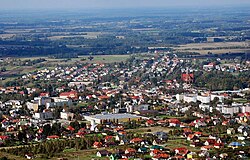Nasielsk
Nasielsk | |
|---|---|
 Skyline of the town | |
| Country | |
| Voivodeship | Masovian |
| County | Nowy Dwór Mazowiecki |
| Gmina | Nasielsk |
| Established | 11th century |
| Town rights | 1386 |
| Government | |
| • Mayor | Bernard Dariusz Mucha |
| Area | |
| • Total | 12.67 km2 (4.89 sq mi) |
| Population (2006) | |
| • Total | 7,364 |
| • Density | 580/km2 (1,500/sq mi) |
| Time zone | UTC+1 (CET) |
| • Summer (DST) | UTC+2 (CEST) |
| Postal code | 05-190 |
| Area code | +48 23 |
| Car plates | WND |
| Website | http://um.nasielsk.pl |
Nasielsk [ˈnaɕɛlsk] is a small town in Masovian Voivodeship, Poland. It is located on a major Warsaw-Gdańsk rail line and serves as a junction, with an additional connection to Sierpc. In the past, the name of the town was spelled in different forms: Nasilzco, Nosidlsk, Nosylsk, Nosydlsk, Nosielsk, Nosselia, Nosidlsko, Nasidlsko, Nosilsko, Nasilsko, Nasylsco.
The Slavic gord of Nosidlsk was first mentioned in 1065, in the so-called Mogilno Falsification of King Bolesław II the Generous for the Benedictine Abbey at Mogilno. As the document stated, the gord of Nosidlsk was an important center of defence, trade and administration. In 1155, a document issued for Duke Boleslaw Kedzierzawy confirmed the existence of the gord at Nasielsk, stating that Nowa Wies near Nasielsk was granted to the abbey of Czerwińsk nad Wisłą. In 1257, Duke of Siemowit I of Masovia granted one-third of Nasielsk to the Czerwinsk Abbey.
By the late 13th century, Nasielsk emerged as the seat of a castellany. First document that confirms this fact was issued in 1297, with the notice of „comes Thomas castellanus de Nosylk”. On November 11, 1386, Janusz I of Warsaw granted the remaining part of the town of Nasielsk (civitas Nostra Nosielsko) to knight Jakusz of Radzanow (Prawdzic coat of arms). Jakusz, who came to be known as Jakusz Bialy of Nasielsk, became the castellan of Nasielsk, and the town remained the property of his family until 1647. The coat of arms of Nasielsk is based on the Prawdzic symbol.
The town with its wooden church of Saint Adalbert of Prague burned in 1440, and five years later, a new brick church was erected. Nasielsk for centuries remained in private hands of the Nosielski and Wessel families. In mid-18th century, first synagogue was built, and in 1795, following the third partition of Poland, Nasielsk was incorporated into the Kingdom of Prussia, where it remained until 1815, when it was incorporated into Russian-controlled Congress Poland. Until 1866, Nasielsk was a private town. In 1877, a rail line from Warsaw to Gdańsk via Nasielsk was completed.
In 1918, Nasielsk returned to Poland, and during the Polish-Soviet War, in 1920, Polish forces clashed here against the advancing Red Army. In 1924, the town became a rail junction after completion of a line to Torun.
The first official inventory of important buildings in Poland, A General View of the Nature of Ancient Monuments in the Kingdom of Poland, led by Kazimierz Stronczynski from 1844–55, describes the Nasielsk Synagogue as one of Poland's architecturally notable buildings.[1]
In 2009, Glenn Kurtz stumbled upon a home video shot by his family that included three minutes of footage in Nasielsk shot in 1938. Kurtz set out to restore the film and find the people in it. The book based on this journey is titled Three Minutes in Poland: Discovering a Lost World in a 1938 Family Film.[2]
Notable people from Nasielsk
- Rabbi Dovid Bornsztain, third Sochatchover Rebbe
- Ola Jordan - Professional dancer on the British TV show Strictly Come Dancing
- Renata Mauer- sports shooter
- Tomasz Majewski - 2008 Olympic gold medalist in shot put
- Jarosław 'PashaBiceps' Jarząbkowski - Professional Counter Strike Player
Notable fictional characters from Nasielsk
T. O. Morrow (real name Tomek Ovadya Morah), DC Comics supervillain
External links
- Jewish Community in Nasielsk on Virtual Shtetl
- [1] Glenn Kurtz's family video showing Nasielsk in 1938
References
- ^ Heaven's Gates; Wooden synagogues in the Territories of the Former Polish-Lithuanian Commonwealth, maria and Kazimierz Piechotka, Wydawnictwo Krupski i S-ka, Warsaw, 2004, p. 174
- ^ http://www.npr.org/2014/11/16/364051174/family-film-offers-glimpse-of-three-minutes-in-poland-before-holocaust



